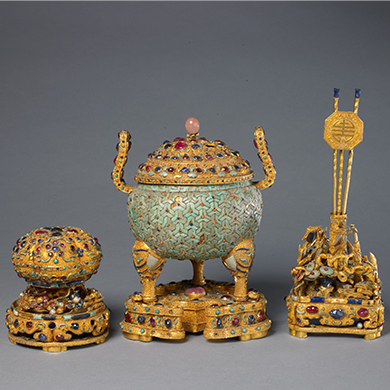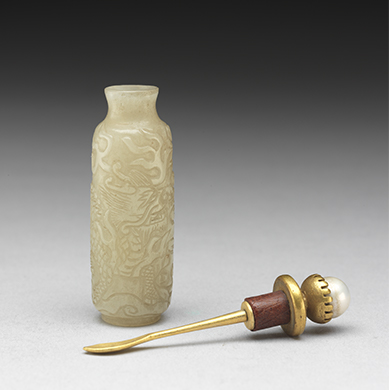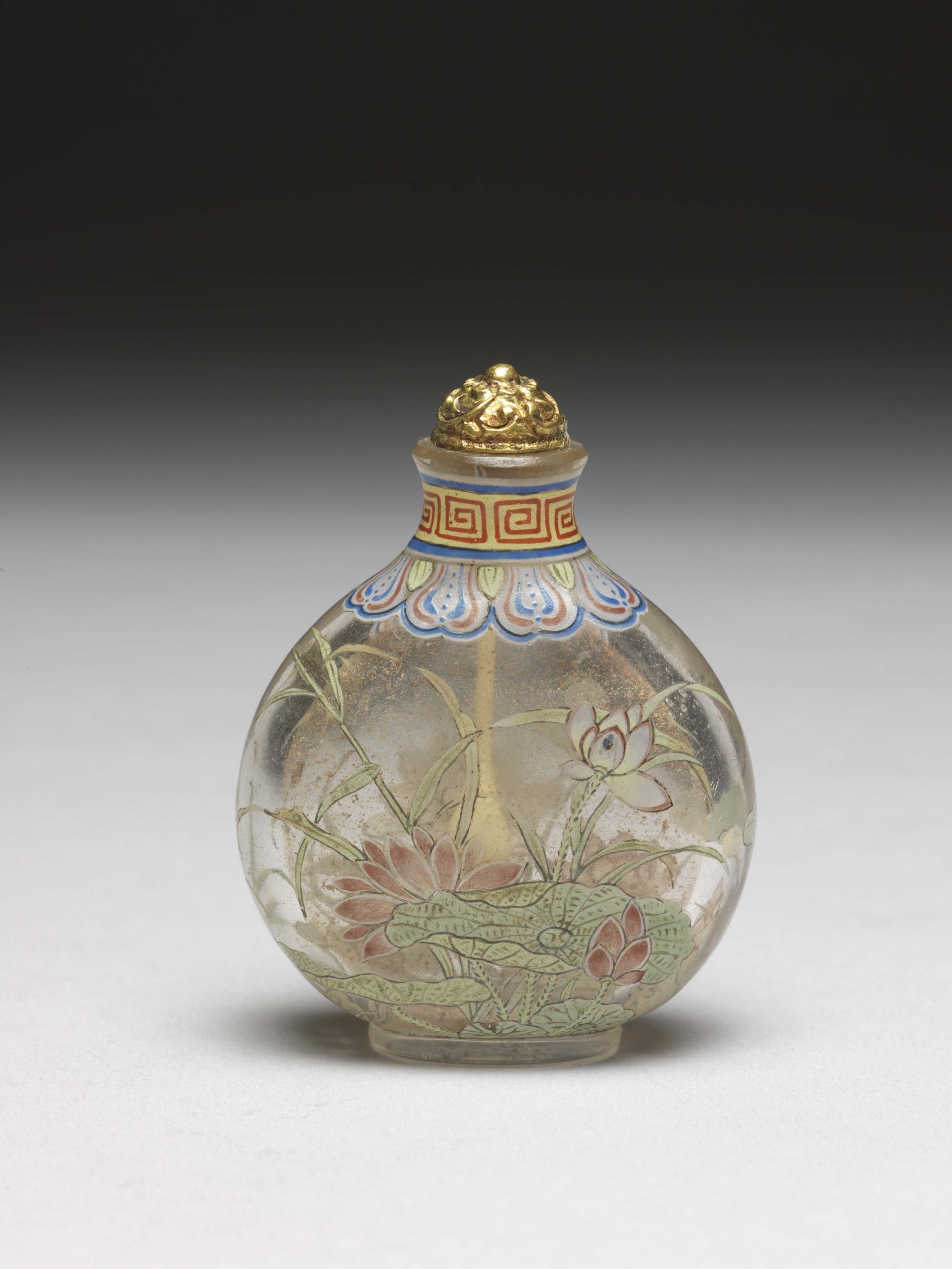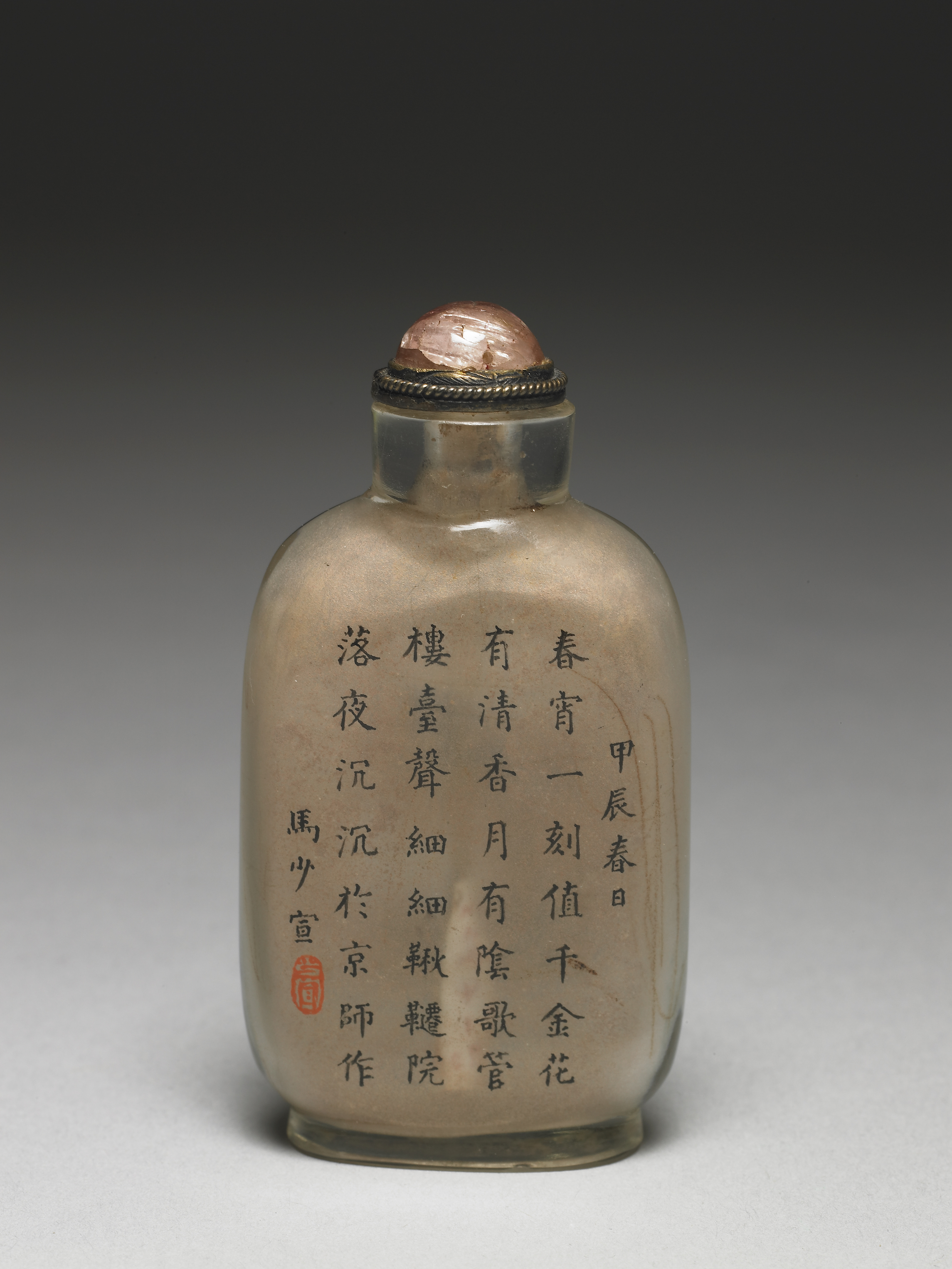Aromatic and Sophisticated
Nowadays, perfume complements sophisticated grooming and enhances the comfort of the family home. In fact, in ancient times, the Chinese had already devised various ways to produce scents to enhance the quality of life. Not only had they developed many formulas for scent production; they also employed various methods to release the scents. For instance, with the indirect method, scent materials are placed away from an open fire and heated on thin tiles or iron and silver plates so that the scent would unravel naturally without producing choking smoke. During the Qing Dynasty, with snuff gaining popularity, snuff bottles were becoming more exquisite and popular by the day, making them desirable items for collection.
Scent Paraphernalia
The Forbidden City upheld very high standards for its aromatic ambience. Following the ancient tradition of incense burning, it had developed many exquisite scent accessories in the form of incense burners, scent boxes, parfumier and sachets, using materials such as copper, porcelain, enamel and jadeite. During the Ming and Qing Dynasties, sets consisting of a burner, a bottle and a box were in fashion. Custom-made side tables were also popular. Later when Western perfume made inroads into life in the Forbidden City, the scent scene became even more vibrant within the palace.

Listening to the Ruan
Listening to the Ruan
Li Song (1166—1243)
(formerly attributed),
Ming Dynasty
From the collection of the National Palace Museum, Taipei
In the painting, a maid is refilling incense at the side table. She holds the box in her left hand and places the incense balls in the incense burner with her right. It is an illustration of how the ancients used incense balls in China.


Rectangular cloisonné enamel censer with eight treasures pattern, Wanli mark, Ming Dynasty
Rectangular cloisonné enamel censer with eight treasures pattern, Wanli mark, Ming Dynasty
Provided by the Palace Museum
On the four sides of the censer, eight treasures pattern is outlined on white enamel ground with the double filigree technique. The gilt bronze lid is decorated with carvings in openwork. With such a censer in the room, the space is scented.


A pair of green jade censers carved with cloud and dragon pattern
A pair of green jade censers carved with cloud and dragon pattern
Provided by the Palace Museum
This pair of censors is placed on both sides of the emperor’s throne. Whenever the emperor takes his seat, sandalwood is burnt in the parfumiers. Wraiths of fragrant smoke from their openings create a superior ambience, and the courtiers smelling them would feel as if they were basking in the emperor’s grace. That is why the pair also get the name “parfumiers of (His Majesty’s) graciousness”.


Rectangular cloisonné enamel lidded burner with figure-like handles, mark of the Xuande period, Qing Dynasty
Rectangular cloisonné enamel lidded burner with figure-like handles, mark of the Xuande period, Qing Dynasty
Provided by the Palace Museum
This is a rare design in incense burners of the Qing Dynasty, with foreigners vividly featured as ‘holders’ for this cloisonné enamel version.


Gold censer in the shape of a gourd in openwork inscribed with the characters of auspiciousness, Qing Dynasty
Gold censer in the shape of a gourd in openwork inscribed with the characters of auspiciousness, Qing Dynasty
Provided by the Palace Museum
The gourd-shaped censer can be placed on the desk or hung up. The openwork makes it an effective effusion fragrance dispenser.


Set of gold filigree incense burner, jar and box inlaid with jewels
Set of gold filigree incense burner, jar and box inlaid with jewels
Provided by the Palace Museum
The lid, handles, legs and stand of the incense burner set are all in gold filigree inlaid with ruby, sapphire and turquoise. The body of the burner is decorated with Y-shaped (also called “chain mail”) patterns inlaid with turquoise. The gold filigree jar inlaid with jewels is placed on a stand carved with pine trees and cranes. A trowel and a pair of chopsticks, used to level the ashes and pick up the incense wood, are placed in the jar. The box for holding incense wood comes with a matching stand carved with plum blossoms.
How the set is used:
- Open the lid of the burner, and level the ashes with the trowel:
- Open the incense box, use the bronze chopsticks to get a piece of incense wood and put it on the ashes in the burner;
- Light the incense and cover the burner with the lid.


Famille rose stick incense holder in the shape of a horse on yellow ground
Famille rose stick incense holder in the shape of a horse on yellow ground
From the collection of the National Palace Museum, Taipei
How it is used: Light an incense stick and insert its end into the hole on the back of the horse.

Embossed glass perfume sprayer traced in gold, Qing Dynasty
Embossed glass perfume sprayer traced in gold, Qing Dynasty
Provided by the Palace Museum

The World on the Palm of One’s Hand
The Qing court pursues the ultimate in tastes regarding the sense of smell and hand-held objects of refinement. It made way for the blossoming of a culture of snuff. Snuff is a fine powder made from ground tobacco leaves with spices added. Qing people believed snuff had medicinal effects for ailments such as chills, dizziness, a stuffy nose, and was good for the eyes and warding off endemics. Snuff was first presented as gift to Emperor Kangxi by Western missionaries. Later when the number of snuff takers grew, they crafted beautiful snuff bottles to carry the snuff more easily.
Snuff bottles were made by the Imperial Workshops and Imperial Kiln of the Qing court. Their production flourished especially during the reigns of Emperors Kangxi, Yongzheng and Qianlong, who often rewarded courtiers with snuff bottles to showcase exquisite craftsmanship as well as to strengthen the emperor-courtier relationship for political ends. The materials used for making snuff bottles during the Qing Dynasty were diverse and can be generally grouped under the categories of glass, enamel with a metal body, jadeite, porcelain and inside-painted. Subject matter for snuff bottles was unlimited; one only needs to open one’s hand to see a whole world of landscapes, figures, flora and fauna unfold.

Lady ruminating after reading, Screen of Twelve Beauties Inscribed by Prince Yong, Qing Dynasty
Lady ruminating after reading, Screen of Twelve Beauties Inscribed by Prince Yong, Qing Dynasty
Provided by the Palace Museum


Painted enamel snuff bottles with flower and bird decorations
Painted enamel snuff bottles with flower and bird decorations
Qianlong period, Qing Dynasty
Provided by the Palace Museum
This pair of snuff bottles features both Chinese and Western characteristics. In the middle are traditional flower and bird patterns with the sides after the European Baroque tradition. The colours are sprightly and the workmanship rigorous and intricate.


Cloisonné enamel and painted enamel on metal snuff bottle with Western figures and two lugs, Qianlong period, Qing Dynasty
Cloisonné enamel and painted enamel on metal snuff bottle with Western figures and two lugs, Qianlong period, Qing Dynasty
From the collection of the National Palace Museum, Taipei
This is an ovoid bronze snuff bottle with two lugs, cloisonné enamel neck and shoulder with ruyi pattern and interlocking sprigs and stylized lotus. It features painted enamel on the body with panels on both sides framed by scrolling foliage, and Western figures of mother and child painted using the inside-painting technique.


Famille rose snuff bottle with interlocking sprigs and lotus pattern, Qianlong period, Qing Dynasty
Famille rose snuff bottle with interlocking sprigs and lotus pattern, Qianlong period, Qing Dynasty
Provided by the Palace Museum
Famille rose is a technique in painted porcelain developed in the Qing Dynasty. Colour is applied on a layer of “glassy white” containing arsenic which gives an opaque effect, resulting in different gradation of colours.


Famille rose snuff bottle with panel of children at play and lugs in the shape of animal masks, Qianlong period, Qing Dynasty
Famille rose snuff bottle with panel of children at play and lugs in the shape of animal masks, Qianlong period, Qing Dynasty
Provided by the Palace Museum
The bottle is decorated with stylized lotus pattern in famille rose all over the body. The panel in the front depicts children at play.


Red lacquered snuff bottle carved with five bats surrounding the character shou (longevity), Qianlong period, Qing Dynasty
Red lacquered snuff bottle carved with five bats surrounding the character shou (longevity), Qianlong period, Qing Dynasty
Provided by the Palace Museum
Lacquer ware has a history of over 7,000 years in China. Raw lacquer collected from lacquer trees, mixed with colour, is applied layer by layer on the body of an article. The number of layers ranges from 80 or 90 to 100 or even 200. Then carving is done on the surface.


Ivory snuff bottle carved with a fishing scene, Qing Dynasty
Ivory snuff bottle carved with a fishing scene, Qing Dynasty
Provided by the Palace Museum
A fishing scene is carved on the snuff bottle in high relief, low relief and openwork. Fishing is a common theme in literati paintings as an expression of a reclusive lifestyle.


Jade snuff bottle with dragon pattern, 18th century, Qing Dynasty
Jade snuff bottle with dragon pattern, 18th century, Qing Dynasty
From the collection of the National Palace Museum, Taipei
Snuff bottle with dragon pattern and auspicious clouds in low relief, matched with bronze cap inset with a pearl.


Inside-painted Shuanghuantu (‘Double Joy’) glass snuff bottle by Ma Shaoxuan, Guangxu 30 (1904), Qing Dynasty
Inside-painted Shuanghuantu (‘Double Joy’) glass snuff bottle by Ma Shaoxuan, Guangxu 30 (1904), Qing Dynasty
From the collection of the National Palace Museum, Taipei
As pigments do not adhere readily on smooth glass, production of an inside-painted snuff bottle involves roughening the internal surfaces of the bottle with sandpaper before painting on the figure or pattern with a specially made bamboo pen.
This snuff bottle features two frolicking badgers painted on one side, and Su Shi’s poem Spring Night inscribed in regular script on the other. It is the work of Ma Shaoxuan, one of four great artists from the Beijing School of inside-painting, renowned for his picture-and-poem style of snuff bottles. An inside-painted snuff bottle Ma Shaoxuan created even won an award at the 1915 Panama World Expo.

Clear glass enamel-painted snuff bottle with lotus pattern, Qianlong period, Qing Dynasty
Clear glass enamel-painted snuff bottle with lotus pattern, Qianlong period, Qing Dynasty
From the collection of the National Palace Museum, Taipei
As the melting points of glass and falangcai (enamel colours) are very similar, it is particularly challenging to apply enamel colours onto glass. If the firing temperature is low, the colours do not integrate thoroughly to produce the best result. If the temperature is high, the glass vessel melts and loses its shape, and has to be discarded. Each colour requires a separate firing, so to create an enamel-painted glass snuff bottle five or six firings are needed.












